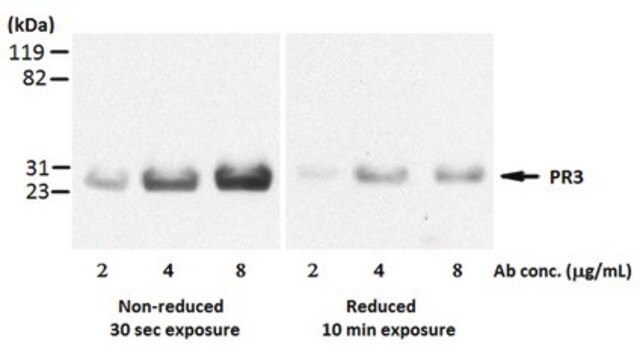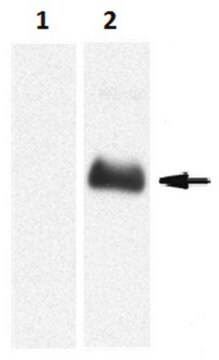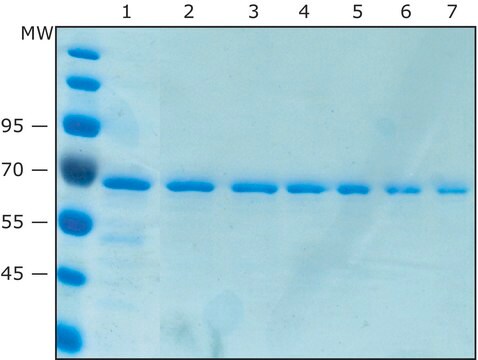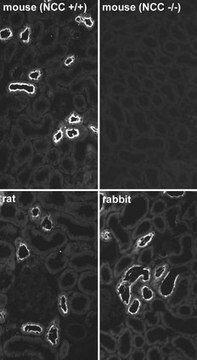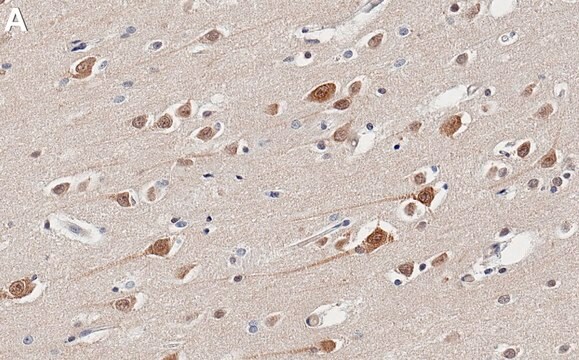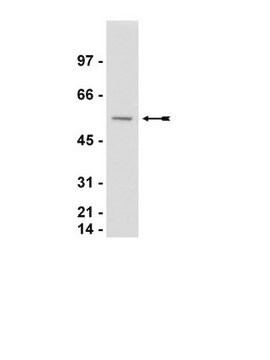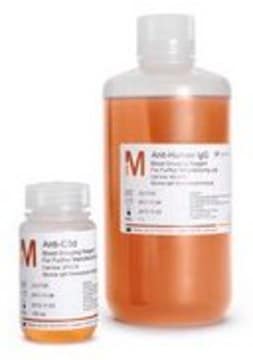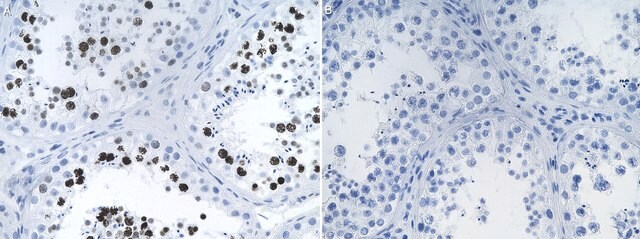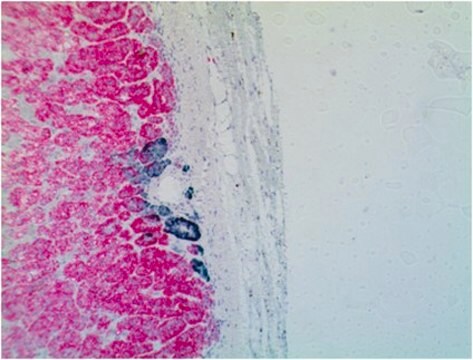MABT340
Anti-Proteinase 3/PR3 Antibody, clone MCPR3-2
clone MCPR3-2, from mouse
別名:
Myeloblastin, AGP7, C-ANCA antigen, Leukocyte proteinase 3, Neutrophil proteinase 4, NP-4, P29, PR-3, PR3, Wegener autoantigen
ログイン組織・契約価格を表示する
すべての画像(1)
About This Item
UNSPSCコード:
12352203
eCl@ss:
32160702
NACRES:
NA.41
クローン:
MCPR3-2, monoclonal
application:
ELISA
FACS
WB
affinity binding assay
FACS
WB
affinity binding assay
化学種の反応性:
human
テクニック:
ELISA: suitable
affinity binding assay: suitable
flow cytometry: suitable
western blot: suitable
affinity binding assay: suitable
flow cytometry: suitable
western blot: suitable
citations:
1
おすすめの製品
由来生物
mouse
品質水準
抗体製品の状態
purified antibody
抗体製品タイプ
primary antibodies
クローン
MCPR3-2, monoclonal
化学種の反応性
human
以下との反応禁止
mouse
テクニック
ELISA: suitable
affinity binding assay: suitable
flow cytometry: suitable
western blot: suitable
アイソタイプ
IgG1κ
NCBIアクセッション番号
UniProtアクセッション番号
輸送温度
wet ice
ターゲットの翻訳後修飾
unmodified
遺伝子情報
human ... PRTN3(5657)
詳細
Myeloblastin (EC 3.4.21.76; UniProt P24158; also known as AGP7, C-ANCA antigen, Leukocyte proteinase 3, Neutrophil proteinase 4, NP-4, P29, PR-3, PR3, Wegener autoantigen) is encoded by the PRTN3 (also known as CANCA, MBN, NP4) gene (Gene ID 5657) in human. Proteinase 3 (PR3) is one of four neutral serine proteases (elastase, cathepsin G, PR3, and neutrophil serine protease 4) stored as fully processed mature enzymes in azurophil granules of human neutrophils. Instead of being targeted to granules after their synthesis, some PR3 molecules end up on the surface of neutrophil plasma membrane in either pro- or mature form. The degree of such surface expression is genetically determined, but the surface exposure and pericellular activity of PR3 around neutrophils can be further upregulated upon neutrophil priming and activation. PR3 autoantibody (anti-neutrophil cytoplasmic antibodies or ANCA) is the main pathogenic feature in patients suffering from granulomatosis with polyangiitis (GPA; formerly called Wegener granulomatosis). ANCAs are shown to activate cytokine-primed neutrophils in vitro by cross-linking surface-exposed PR3 and Fcγ receptors. PR3 activity and/or its inactivation by alpha 1-antitrypsin/alpha-1 proteinase inhibitor (α1PI) varies in the human population and contributes to the risk for GPA manifestations either at onset, during relapses, or during systemic progression. PR3 is initially produced with a signal peptide sequence (a.a. 1-25), an N-terminal and a C-terminal propeptide sequence (a.a. 26-27 and 249-256, respectively), the removal of which yields the mature enzyme (a.a. 28-248).
特異性
Clone MCPR3-2 detected wild-type PR3 and the catalytically inactive S176A PR3 mutant, but not neutrophil elastase or cathepsin G. Clone MCPR3-2 did not interfere with PR3 enzymatic activity or its interaction with α1-protease inhibitor/α1-PI (Sun, J., et al. (1998). J. Immunol. Methods. 211(1-2):111-123). The ratios of OD readings obtained with PR3-complexed clone MCPR3-2 to the corresponding ODs obtained with PR3-complexed clone MCPR3-3 (Cat. No. MABF973) in ELISA-based serum PR3 autoantibodies (ANCAs) measurements correlate well with the neutralizing activity of ANCAs in patients serum samples (Silva, F., et al. (2010). J. Autoimmun. 35(4) 299-308).
免疫原
Epitope: “North-East” of the substrate-binding pocket and adjacent to clone MCPR3-3 epitope (Silva, F., et al. (2010). J. Autoimmun. 35(4) 299-308).
Granule extract from HMC-1/PR3 mast cells expressing transfected human neutrophil PR3 (Sun, J., et al. (1998). J. Immunol. Methods. 211(1-2):111-123).
アプリケーション
Research Category
細胞骨格
細胞骨格
Research Sub Category
炎症及び自己免疫疾患
炎症及び自己免疫疾患
Anti-Proteinase 3/PR3 Antibody, clone MCPR3-2 is an antibody against PR3 for use in Affinity Binding Assay, ELISA, Flow Cytometry, and Western Blotting.
Western Blotting Analysis: 2 µg/mL from a representative lot detected 5 µg of purified human neutrophil PR3 under both non-reducing and reducing conditions (Courtesy of Amber Hummel, Mayo Clinic, Rochester, MN).
Flow Cytometry Analysis: A representative lot detected a large population of human peripheral blood neutrophils with surface PR3. The entire population became positively stained after TNFa-stimulation (Hinkofer, L.C., et al. (2013). J. Biol. Chem. 288(37):26635-26648).
Flow Cytometry Analysis: A representative lot bound immobilized recombinant human PR3 via a distinct epitope than those recognized by clone MCPR3-3 and MCPR3-7 (Cat. No. MABF973 and MABT403, respectively) as determined by FACS analysis of bead-based competition binding assay (Silva, F., et al. (2010). J. Autoimmun. 35(4) 299-308).
Flow Cytometry Analysis: A representative lot bound recombinant human PR3-, but not murine PR3-, coated Talon-beads as determined by FACS analysis. (Silva, F., et al. (2010). J. Autoimmun. 35(4) 299-308).
ELISA Analysis: Representative lots were immobilized on well surface and employed to capture purified human polymorphonuclear cell PR3 or recombinant human PR3 S176A mutant, followed by affinity pull-down of PR3 autoantibodies (anti-neutrophil cytoplasmic antibodies or ANCA) from patients serum samples by the captured PR3 and the subsequent detection of the bound ANCA by alkaline phosphatase-conjugated goat anti-human IgG (Silva, F., et al. (2010). J. Autoimmun. 35(4) 299-308; Sun, J., et al. (1998). J. Immunol. Methods. 211(1-2):111-123).
Western Blotting Analysis: A representative lot detected an exogenously expressed S176A mutant PR3 in lysates from transfected HMC-1 human mast cells as well as purified PR3 from human polymorphonuclear cells (Sun, J., et al. (1998). J. Immunol. Methods. 211(1-2):111-123).
Affinity Binding Assay: A representative lot captured a recombinant human PR3 construct proP-PR3ctp that adopts a pro-PR3 conformation and a recombinant construct ΔPR3ctp-S195A that adopts a mature PR3 conformation with similar affinity (Hinkofer, L.C., et al. (2013). J. Biol. Chem. 288(37):26635-26648).
Flow Cytometry Analysis: A representative lot detected a large population of human peripheral blood neutrophils with surface PR3. The entire population became positively stained after TNFa-stimulation (Hinkofer, L.C., et al. (2013). J. Biol. Chem. 288(37):26635-26648).
Flow Cytometry Analysis: A representative lot bound immobilized recombinant human PR3 via a distinct epitope than those recognized by clone MCPR3-3 and MCPR3-7 (Cat. No. MABF973 and MABT403, respectively) as determined by FACS analysis of bead-based competition binding assay (Silva, F., et al. (2010). J. Autoimmun. 35(4) 299-308).
Flow Cytometry Analysis: A representative lot bound recombinant human PR3-, but not murine PR3-, coated Talon-beads as determined by FACS analysis. (Silva, F., et al. (2010). J. Autoimmun. 35(4) 299-308).
ELISA Analysis: Representative lots were immobilized on well surface and employed to capture purified human polymorphonuclear cell PR3 or recombinant human PR3 S176A mutant, followed by affinity pull-down of PR3 autoantibodies (anti-neutrophil cytoplasmic antibodies or ANCA) from patients serum samples by the captured PR3 and the subsequent detection of the bound ANCA by alkaline phosphatase-conjugated goat anti-human IgG (Silva, F., et al. (2010). J. Autoimmun. 35(4) 299-308; Sun, J., et al. (1998). J. Immunol. Methods. 211(1-2):111-123).
Western Blotting Analysis: A representative lot detected an exogenously expressed S176A mutant PR3 in lysates from transfected HMC-1 human mast cells as well as purified PR3 from human polymorphonuclear cells (Sun, J., et al. (1998). J. Immunol. Methods. 211(1-2):111-123).
Affinity Binding Assay: A representative lot captured a recombinant human PR3 construct proP-PR3ctp that adopts a pro-PR3 conformation and a recombinant construct ΔPR3ctp-S195A that adopts a mature PR3 conformation with similar affinity (Hinkofer, L.C., et al. (2013). J. Biol. Chem. 288(37):26635-26648).
品質
Identity Confirmation by Isotyping Test.
Isotyping Analysis: The identity of this monoclonal antibody is confirmed by isotyping test to be IgG1κ.
Isotyping Analysis: The identity of this monoclonal antibody is confirmed by isotyping test to be IgG1κ.
ターゲットの説明
~29 kDa observed. 27.81 kDa (Pro-PR3; a.a. 1-256), 25.14 kDa (N-terminal signal and propeptide removed; a.a. 28-256), 24.25 kDa (Mature; a.a. 28-248) calculated.
物理的形状
Protein G Purified
Format: Purified
Purified mouse monoclonal IgG1κ antibody in buffer containing 0.1 M Tris-Glycine (pH 7.4), 150 mM NaCl with 0.05% sodium azide.
保管および安定性
Stable for 1 year at 2-8°C from date of receipt.
その他情報
Concentration: Please refer to lot specific datasheet.
免責事項
Unless otherwise stated in our catalog or other company documentation accompanying the product(s), our products are intended for research use only and are not to be used for any other purpose, which includes but is not limited to, unauthorized commercial uses, in vitro diagnostic uses, ex vivo or in vivo therapeutic uses or any type of consumption or application to humans or animals.
適切な製品が見つかりませんか。
製品選択ツール.をお試しください
保管分類コード
12 - Non Combustible Liquids
WGK
WGK 1
引火点(°F)
Not applicable
引火点(℃)
Not applicable
適用法令
試験研究用途を考慮した関連法令を主に挙げております。化学物質以外については、一部の情報のみ提供しています。 製品を安全かつ合法的に使用することは、使用者の義務です。最新情報により修正される場合があります。WEBの反映には時間を要することがあるため、適宜SDSをご参照ください。
Jan Code
MABT340:
試験成績書(COA)
製品のロット番号・バッチ番号を入力して、試験成績書(COA) を検索できます。ロット番号・バッチ番号は、製品ラベルに「Lot」または「Batch」に続いて記載されています。
ライフサイエンス、有機合成、材料科学、クロマトグラフィー、分析など、あらゆる分野の研究に経験のあるメンバーがおります。.
製品に関するお問い合わせはこちら(テクニカルサービス)